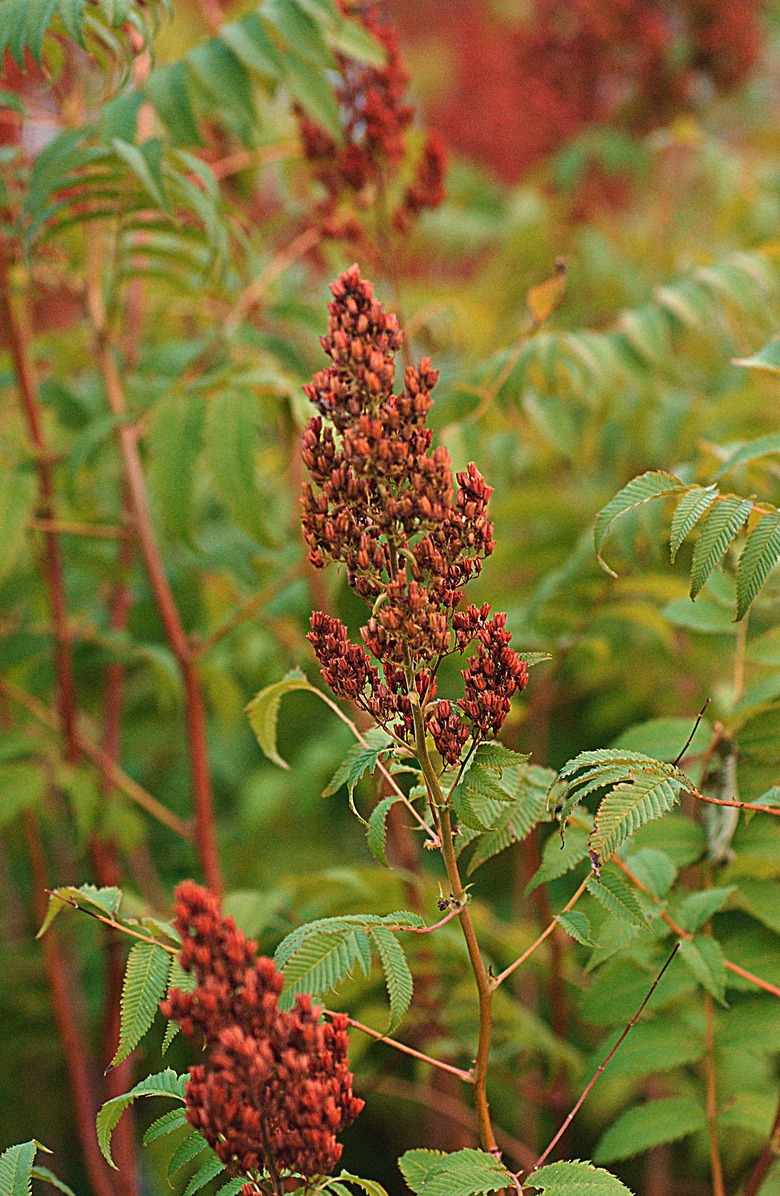How To Grow Sumac From Seed
Sumacs (Rhus spp.) are deciduous shrubs that generally thrive in U.S. Department of Agriculture plant hardiness zones 3 to 11, although this varies slightly from species to species. They often grow to 15 to 25 feet tall, but some cultivars and fragrant sumac (Rhus aromatica) grow to only 2 to 6 feet tall. Sumacs are usually propagated with cuttings, but they can be grown from seeds. The seeds can be purchased or the huge clusters of ripe, bright red berries can be collected from nearby trees in the fall.
Step 1
Step 1
Soak the ripe berries in water overnight. Scrape them over a screen or sieve to clean the pulp from the seeds. Rinse the seeds under warm water to remove any remaining pulp. Soak freshly cleaned and purchased seeds for 12 to 24 hours in room-temperature water.
- are deciduous shrubs that generally thrive in U.S. Department of Agriculture plant hardiness zones 3 to 11, although this varies slightly from species to species.
- Scrape them over a screen or sieve to clean the pulp from the seeds.
Step 2
Step 2
Combine peat and perlite in equal amounts, and moisten the mixture. Place a 1/2-inch depth of moist mix in a sealable container. Sprinkle the seeds evenly over the mix. Pour another 1/2 inch of moist mix over the seeds. Place them in the refrigerator for three to four months.
Step 3
Step 3
Remove the seeds from the refrigerator. Fold a piece of sandpaper in half with the grit side facing in. Place a seed between the two sides of sandpaper. Hold the sandpaper with the seed pinched between your finger and thumb, and rub the sandpaper back and forth over the seed about 40 times or until the seed coat is dull but not pitted. Repeat this process with each seed.
- Combine peat and perlite in equal amounts, and moisten the mixture.
- Place a seed between the two sides of sandpaper.
Step 4
Step 4
Sow the seeds in a moistened half and half mixture of sphagnum peat moss and perlite. Use either flats or small containers that are 3 to 4 inches deep with drain holes in the bottom. Press each seed 3/4 inch deep into the moistened mix, and push the mix back over the seed. Space the seeds 1 inch apart.
Step 5
Step 5
Set the containers in an old aquarium and cover the top to hold in moisture, or put a piece of hard plastic over the flat. Alternately, put the containers into clear plastic bags and seal them. Put them in a bright, sunny area, but do not expose them to direct sunlight. Maintain room temperatures of 68 to 70 degrees Fahrenheit. Water them gently if the mix begins to dry.
- Sow the seeds in a moistened half and half mixture of sphagnum peat moss and perlite.
- Press each seed 3/4 inch deep into the moistened mix, and push the mix back over the seed.
Step 6
Step 6
Take the cover off the aquarium or flat, or open the tops of the plastic bags after the seeds germinate and the small seedlings are visible. Germination takes two to four weeks. Water them when the top of the mix begins to dry. Transplant them into separate containers with soil-based potting mix when the seedlings are 3 to 4 inches tall.
Step 7
Step 7
Grow them in containers in bright indirect sunlight until fall. Water them when the top of the soil begins to dry. Each seedling will usually require 1/3 gallon of water twice per week but they may need to be watered more frequently, depending on temperatures and humidity. Transplant them into slightly larger containers if they become root-bound. Set them in direct morning sunlight for gradually longer periods of time in early fall. Reduce the watering frequency gradually to get them used to dryer conditions. Plant them outdoors in mid-autumn.
- Take the cover off the aquarium or flat, or open the tops of the plastic bags after the seeds germinate and the small seedlings are visible.
- Transplant them into separate containers with soil-based potting mix when the seedlings are 3 to 4 inches tall.
Warning
Berries from sumacs commonly grown in cultivation are actually edible; however, they are within the same plant family as poison sumacs (Toxicodendron vernix). The berries from Rhus spp. sumacs may be toxic to people who are allergic to poison sumac or any other plants within the cashew plant family. Non-poisonous Rhus spp. have red berries while poison sumacs produce white berries.
Things Needed
- Screen or sieve
- Peat
- Perlite
- Sealable container
- Sandpaper
- Flats or small containers
- Aquarium (optional)
- Piece of hard plastic (optional)
- Clear plastic bags (optional)
- Individual containers
- Soil-based potting mix
References
- Missouri Botanical Garden: Rhus Aromatica
- Floridata: Rhus Copallinum
- Missouri Botanical Garden: Rhus Glabra
- Missouri Botanical Garden: Rhus Typhina
- Missouri Botanical Garden: Rhus Typhina "Bailtiger" Tiger Eyes
- University of Florida: Environmental Horticulture: Rhus Aromatica
- University of Washington: Plant Propagation Protocol for Rhus Glabra
- Clemson Cooperative Extension: Home & Garden Information Center: Planting Shrubs Correctly
